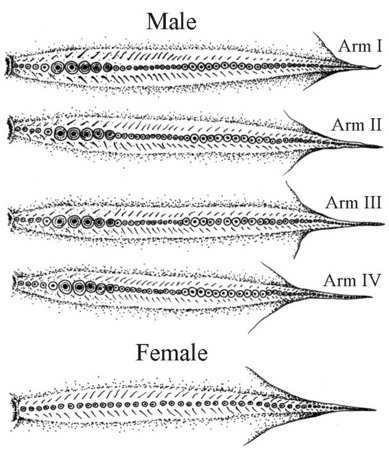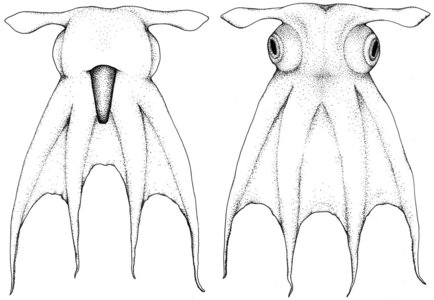Opisthoteuthis borealis
Martin Collins, Roger Villanueva, and Richard E. Young
Introduction
Opisthoteuthis borealis is a medium-sized species reaching 75 mm ML and having a semi-gelatinous body. The description is based on 9 specimens that had been frozen prior to fixation and were in rather poor condition. O. borealis is known only from the high North Atlantic where it is the most northernly species of the genus in the Atlantic.
Characteristics
- Arms and web
- Arms in adults with 75-82 suckers.
- Proximal-most cirrus generally between suckers 3 and 4; cirri short, longest in mid region of arm, length 3.1-6.1 mm (5-10% ML).
- Web without single or multiple “nodules” (i. e., without trabecula-like muscular supports).
- Mature male
- Arms I slightly thickened.
- Two fields of distinctly enlarged, bulbous suckers on all arms; proximal field includes sucker numbers 5-10 with sucker number 6 or 7 largest; distal field starts with sucker number 23 or 24, contains 9-14 suckers with sucker number 27-30 usually largest.
- Distal field similar on all arms in length and sucker sizes.
- Maximum sucker diameter in distal and proximal fields approximately equal.
- Female
- Females without distinctly enlarged sucker fields; maximum sucker size between suckers 10 and 20.
- Females without distinctly enlarged sucker fields; maximum sucker size between suckers 10 and 20.
 Click on an image to view larger version & data in a new window
Click on an image to view larger version & data in a new window
Figure. Oral views of the arms of O. borealis showing emlarged sucker fields in mature males and their absence in females. Drawings from Collins (2006).
- Digestive system
- Digestive gland not divided into two parts (i. e., digestive gland entire)
- Digestive gland not divided into two parts (i. e., digestive gland entire)
Comments
More details of the description of O. borealis can be found here.
The above description is from Collins (2006).
Comparison of Atlantic Species of Opisthoteuthis
| O. borealis | O. agassizii | O. massyae | O. grimaldii | O. calypso | O. hardyi | |
| Digestive gland | Undivided | Undivided | Divided | Divided | Undivided | Undivided |
| Increased thickness, Arms I, mat. males | Slight | Absent | Marked | Absent | Absent | Slight |
| Distal sucker field, mat. males, location | 22-36 | 30-41 | 34-50 | 22-39 | 23-29 | 18-32 |
| Distal sucker field, mat. males, location of max. sucker diameter | 27-30 | 34-36 | 40-41 | 29-31 | 26 | 22-24 |
| Distal sucker field, mat. males, number of suckers | 9-14 | 7-8 | 9-11 | 9-10 | 2-3 | 9-14 |
| Arm sucker count | 75-82 | 58-80 | 82-106 | 73-80 | 47-58 | 60-67 |
| First cirrus: location between suckers | 3 & 4 | 3 & 4 | 3 & 5 | 2 & 3 | 1 & 2 | 3 & 4 |
| Ovarian egg length (mm) | 11-12 | 8-10 | 9-11 | no data | 7-7.5 | no data |
Life History
Distal oviduct of a mature female had 10 eggs 11-12 mm in length and had 220 oocytes from 3-12 mm in the ovary.Distribution
Type locality: 63°10’N 54°14’W; 1321-1319 m.
Distribution: North Atlantic near the east and west coasts of southern Greenland from 957-1321 m depth (3.0-3.5°C).
References
Collins, M.A. 2006. Opisthoteuthis borealis: A new species of cirrate octopod from Greenland waters. Journal of the Marine Biological Association of the United Kingdom 85: 1475-1479.
Title Illustrations

| Scientific Name | Opisthoteuthis borealis |
|---|---|
| Location | Off west coast of southern Greenland, North Atlantic |
| Reference | Collins, M.A. 2006. Opisthoteuthis borealis: A new species of cirrate octopod from Greenland waters. Journal of the Marine Biological Association of the United Kingdom 85: 1475-1479. |
| Sex | Male |
| Life Cycle Stage | Mature |
| View | Ventral, dorsal |
| Size | 60 mm ML |
| Collection | ZMUC CEPH-3 |
| Type | Holotype |
| Copyright |
© Martin Collins

|
About This Page
Martin Collins

Aberdeen University, Aberdeen, UK

Instituto de Ciencias del Mar (CSIC), Barcelona, Spain

University of Hawaii, Honolulu, HI, USA
Correspondence regarding this page should be directed to Martin Collins at , Roger Villanueva at , and Richard E. Young at
Page copyright © 2016 Martin Collins, , and
All Rights Reserved.
- First online 27 May 2008
- Content changed 27 February 2016
Citing this page:
Collins, Martin, Roger Villanueva, and Richard E. Young. 2016. Opisthoteuthis borealis . Version 27 February 2016 (under construction). http://tolweb.org/Opisthoteuthis_borealis/68278/2016.02.27 in The Tree of Life Web Project, http://tolweb.org/









 Go to quick links
Go to quick search
Go to navigation for this section of the ToL site
Go to detailed links for the ToL site
Go to quick links
Go to quick search
Go to navigation for this section of the ToL site
Go to detailed links for the ToL site